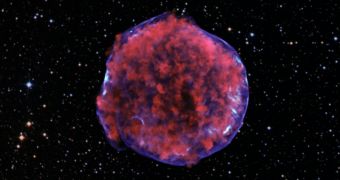A group of astronomers from the Harvard-Smithsonian Center for Astrophysics (CfA) announces the discovery of an extremely-fast shock wave traveling through the remains of a huge stellar explosion.
The work was centered on a supernova remnant called SN 1572, which was discovered in early November 1572 by multiple astronomers. This blast was so strong that it became one of a select group of eight supernova explosions that were visible from Earth with the unaided eye throughout history.
The object is also known as Tycho's Supernova, B. Cassiopeiae (B. Cas), or 3C 10. It is located relatively close to Earth, in the constellation Cassiopeia, and the blast that created it was cataloged as a Type Ia supernova. This means that it originated in a former binary system that featured a white dwarf.
Tycho's Supernova lies between 8,000 and 9,800 light-years from Earth, which makes it an excellent target for astronomical observations. In the latest study, CfA investigators were able to establish that a shock wave is still pushing ever-outwards, at 300 times the speed of sound.
However, what the team did not expect to find was the presence of a reverse shock wave, traveling towards the center of the supernova remnant at 1,000 times the speed of sound. Such structures have yet to be detected around other remnants, but astrophysicists plan to look for some more carefully.
The extreme speed of the shock wave heats up the clouds of gas, dust and other matter around the former star, causing them to release massive volumes of highly-energetic radiations, such as X-rays.
The reverse shock wave resembles “the wave of brake lights that marches up a line of traffic after a fender-bender on a busy highway,” says CfA astronomer and study coauthor Randall Smith.
“We wouldn't be able to study ancient supernova remnants without a reverse shock to light them up,” adds Hiroya Yamaguchi, who is the leader of the new study, and also an astronomer at CfA.
Due to the fact that the reverse shock wave keeps illuminating the supernova remnant, scientists can continue to analyze it even today, centuries after the original star blew up. “Thanks to the reverse shock, Tycho's supernova keeps on giving,” Smith concludes, quoted by Space.

 14 DAY TRIAL //
14 DAY TRIAL //